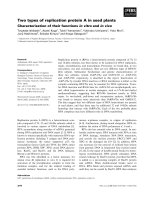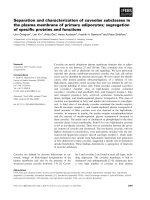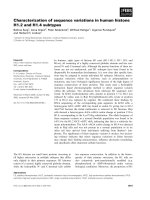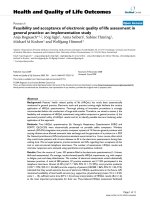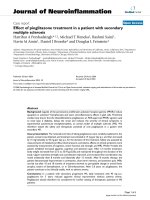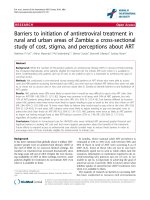Characterization of fruit morphological parameters and effect of presowing treatment in Phoebe Cooperiana: An economically important wild edible fruit of Arunachal Pradesh
Bạn đang xem bản rút gọn của tài liệu. Xem và tải ngay bản đầy đủ của tài liệu tại đây (252.41 KB, 8 trang )
Int.J.Curr.Microbiol.App.Sci (2019) 8(4): 2704-2711
International Journal of Current Microbiology and Applied Sciences
ISSN: 2319-7706 Volume 8 Number 04 (2019)
Journal homepage:
Original Research Article
/>
Characterization of Fruit Morphological Parameters and Effect of PreSowing Treatment in Phoebe Cooperiana: An Economically Important
Wild Edible Fruit of Arunachal Pradesh
Narang Dolley1, N. Lyngdoh1*, M. Bishwapati Devi2 and B.N. Hazarika3
1
Department of Tree Improvement, 2Department of Basic Sciences, 3Office of the Dean,
College of Horticulture and Forestry, Central Agricultural University, Pasighat, Arunachal
Pradesh-791102, India
*Corresponding author
ABSTRACT
Keywords
Tapir, Germination,
Gibberlic acid, Adi
Article Info
Accepted:
20 March 2019
Available Online:
10 April 2019
The experiment was conducted to characterize the fruit morphological parameters and to
study the effect of different pre-sowing treatment on seeds of wild edible fruit tree Phoebe
cooperiana U.N Kanjilal ex A. Das. of Arunachal Pradesh. Fruit and seed morphological
parameters were based on 100 fruits collected from Lower Dibang district of Arunachal
Pradesh. Eight pre-sowing treatments in three replications were given to the seeds before
sowing at Department of Tree Improvement nursery, College of Horticulture and Forestry,
Pasighat, Arunachal Pradesh. The average fruit weight for the 100 fruits was recorded to
be 9.64 ± 1.90g; fruit length 3.62 ± 0.37cm; fruit diameter 2.42 ± 0.59cm; seed weight3.10
± 0.70g; seed length 2.45 ± 1.01cm; seed diameter 1.35 ± 0.24cm; pulp weight 6.69 ±
1.10g; pulp thickness 1.07 ± 0.10cm and pulp-fruit ratio 0.64 ± 0.21. Significant
differences in germination were observed across the treatments. The study revealed that
treatment T5 (soaking in 0.05% gibberellic acid for 12 hrs) showed highest germination
percentage (51.40) followed by T4 (soaking in 2 % H2O2 12hrs). Although by soaking of
seed in water the germination percentage was significantly lower (40.14% and 38.34%) it
can be resorted as an economical method of seed treatment for higher seedling production.
Introduction
The consumption and sale of wild edible
fruits is a habit for scores of people residing
in rural areas. Besides being the only source
of nutritional supplement (Ruel et al., 2005;
Balemie et al., 2006; Seal, 2011) for which
they can afford and or access, wild edible
fruits are also known to subsidize family
income (Falconer, 1990; Seal et al., 2014;
Chakravarty et al., 2016) of rural people.
Lately, many wild edible fruits such as Anola,
Rambutan, star fruits, Jackfruit, etc. have
attained greater importance and there is large
scale commercialization of the species.
Systematic domestication and integration into
mainstream
agriculture
have
ensured
sustainable harvest without affecting natural
2704
Int.J.Curr.Microbiol.App.Sci (2019) 8(4): 2704-2711
gene-pool. But for many, wild extraction is
still followed and patterns and frequency of
extraction has turned out to be unsustainable.
The demand that began to emerge from urban
areas has entailed huge economic prospects to
collectors,
contractors
and
retailers.
Consequently the scale of extraction has
escalated imposingsevere ecological threat to
these species.
In Arunachal Pradesh, India Phoebe
cooperiana U.N Kanjilal ex A. Dasfruits are
highly demanded throughout the state. The
tree is tall with compact crown attaining the
height of approximately 30 metres and girth
of 3 metres (Plate 1). It belongs to family
Lauraceae and mainly distributed in tropical
and subtropical rainforest of northeast India
along the foothills of Eastern Himalayas upto
an altitude 1600 m above msl. Popularly
known as Mekhai in Assam, it has many local
names in Arunachal Pradesh viz- Tapir/Tapil
(Adi), Sangcher/Jishir (Nyishi), Samper
(Apatani), Hisir (Galo), Educhi (Idu Mishmi)
etc. The fruit is a berry which is 2-3.5 cm
long, ellipsoid in shape, the immature fruit is
greenish and black on ripe, inner part of the
ripen fruit is oily, yellowish green with
characteristic aroma and bitter taste (Plate
2).Fruits are available from September to
December with an average cost ranging
between Rs. 400/- to Rs. 500/- for 100 fruits
in local markets. In addition, the tree is
known for its quality timber with a compact
crown and a clean bole of 15-18m length
which is in high demand mainly by plywood
industries. Owing to the desirable timber
characters as well as edible nature of fruits,
there is a huge demand for planting material
of this species among the local community,
forestry and private sectorsas well. Many
farmers have started raising nurseries of the
species and a single seedling can fetch a price
of upto Rs.80/-. However, the species has not
received the limelight it deserves from the
scientific community. As per of now, there is
no information on the basic morphological,
nutritive characters of the fruits and neither on
the ecology, reproductive biology and
propagation methods of the species. In
addition, the species is facing tremendous
anthropogenic pressure from indiscriminate
felling (Payum et al., 2013) and harvest of
immature fruits. Consequently, population
sizes have dwindled and natural regeneration
scanty effecting population build up.
Presently there is a huge demand for planting
material of the species but since the
vegetative methods of propagation have been
not been developed, the only method of
regeneration is from seeds. But with very few
matured seeds available for multiplication the
challenge is to produce maximum plantable
seedlings from available seeds. In this regard,
standardizing pre-sowing treatment for
maximum germination becomes necessary.
The use of pre-sowing treatments for
acceleration and enhancement of seed
germination of some wild edible fruit trees
include those of Ziziphus mauritiana and
Macadamia integrifolia (Mbora, 2012),
Elaeocarpus serratus (Dahanayakeet al.,
2013), Terminalia chebula (Hossain et al.,
2013), Manilkara hexandra (Bajaniya et al.,
2018). Considering the overall lack of
information on the species and the need to
obtain information on the germination
patterns of the species, we characterize fruit
morphological parameters and investigate
effects of pre-sowing treatment on seed
germination of Phoebe cooperiana in the
nursery condition.
Materials and Methods
Matured fruits of Phoebe cooperiana were
collected during the month of November
(2016) from Jia(Giya) under Roing Forest
Range (28°03′32′′ N latitude; 95°46′03′′ E
longitude, at 169 m elevation), Lower Dibang
Valley District, Arunachal Pradesh.
2705
Int.J.Curr.Microbiol.App.Sci (2019) 8(4): 2704-2711
Characterization of fruit morphology
Hundred fruits where used for characterizing
fruit morphological parameters. Fruits weight
was measured using electronic (digital)
balance and expressed in gram (g).The fruit
length is the linear extended space from top
point of the fruit to bottom point of the fruit
apex. Fruit length and diameter was measured
at the longest and widest point using Digital
Calliper and expressed in centimetre (cm).
After pericarp was removed, the seed weight
was taken using electronic Balance and
expressed in gram (g). Seed length and
diameter was measured at the longest and
widest point using Digital Calliper and
expressed in centimetre (cm).
Pulp weight was estimated using formula:
)g
Pulp thickness was estimated using formula:
Pulp-fruit ratio was determined by formula:
Pre-sowing treatment
Seeds were depulped manually and shade
dried for one day for studying the effects of
different pre-treatment on the germination
parameters. A total of 300 seeds in three
replicate with 100 seed per replicate were
taken separately for each treatment for
germination experiment in nursery condition.
Each replicate of seeds were subjected to the
following treatments: (T1) - Control without
any treatment; (T2) - Soaking in water for 12
hours; (T3) - Soaking in water for 24 hours;
(T4) - Soaking in 2 % Hydrogen peroxide
(H2O2) for 12hours, (T5) - Soaking in 0.05 %
Gibberellic acid (GA) for 12 hours, (T6) Soaking in 0.1% Gibberellic acid (GA) for 12
hours, (T7) - Soaking in 0.1% Potassium
nitrate (KNO3) for 12 hours, (T8) - Soaking in
0.5% Potassium nitrate (KNO3) for 12 hours.
Immediately after the pre-treatments, seeds
were sown in prepared nursery beds and
mulching was done. Watering was carried out
regularly as per the requirement and observed
daily for initiation and progress of
germination until no more germination was
observed. The first germination was started on
37th day after sowing which was expressed as
days to initial germination and was taken as
visible signs of successful germination and
data was recorded. The number of days on
which the last seedling emerged was recorded
and expressed as days to final germination. It
took 70 days to complete the germination
experiment from the date of sowing.
The various germination parameters such as
germination percentage, peak value and
germination value were calculated at the end
of the experiments. Each treatment and the
control were laid in Completely Randomized
Design. Values of germination percentage
were
transformed
(arcsine-square-root
transformation) prior to analysis and were
back transformed for tabular presentation.
The obtained data was analysed using the
analysis of variance procedure (ANOVA)
variance following the model suggested by
Panse and Sukhatme (1985). At the end of the
germination
period,
the
germination
percentage, peak value, germination values
were calculated using the following
equations:
Germination percentage
The germination test was carried out in which
four replicates of 100 seeds each were used
(ISTA, 2003). The germination percentage
was calculated using the formulae as:
Germination Percentage =
Number of seeds germinated
-------------------------------------x 100
Total number of seeds used
2706
Int.J.Curr.Microbiol.App.Sci (2019) 8(4): 2704-2711
Peak value
Peak value was calculated as the maximum
mean daily germination (MDG) reached at
any time during the period of test (Czabator,
1962).
Germination value
Czabator's formula (1962), which quantifies
germinative energy by combining speed and
completeness of germination, was used for
evaluation of the treatments.
Germination Value = Final DGS X Peak
value; where DGS is (Daily Germination
Speed)
Results and Discussion
The average fruit weight for the 100 fruits
was found to be 9.64 g, fruit length 3.62cm
and fruit diameter was 2.42cm,while seed
weight, seed weight and seed diameter was
found to be was 3.10 g, 2.45cm and 1.35cm,
respectively (Table 1). The fruits are much
larger than those of its close associate Phoebe
goalparensis, an important timber species of
the region (Jana and Singh, 2017) but slightly
smaller than that of Elaeocarpus floribundus,
the Indian olive (Bhowmick, 2017). Seed
morphological
parameters
are
also
comparable to those of Elaeagnus latifolia, an
underutilized fruit of the region (Patel et al.,
2015) which showed mean seed weight of
3.19 g, seed length 2.80 cm and seed diameter
1.29 cm. One of the most important fruit
parameters among edible fruits are the pulp
content and pulp fruit ratio. These characters
increase the marketability of the fruit.
Average pulp weight, pulp thickness and
pulp-fruit ratio was found to be 6.69 g,
1.07cm and 0.53 respectively (Table 1). These
values are comparable to the pulp weight
(3.67 to 10.33 g) and pulp-fruit ratio (0.57 to
0.80) of Jamun (Singh et al., 2016; Rakesh,
2013), pulp thickness (5.64 to 6.72 mm) and
pulp-fruit ratio (0.69 to 0.74) of P.
nepaulensis (Rymbai et al., 2016).
Effect of different pre-sowing treatments on
seed germination values of P. cooperianais
presented in Table 2. The maximum
germination percentage (51.40 %) was
recorded in the treatment T5 (soaking in 0.05
% GA for 12 hours). This higher germination
percent confirmed the role of Gibberellic acid
as a stimulatory agent (Cetinbas and
Koyuncu, 2006; Negi and Sharma, 2011). The
highest germination value of T5 was followed
by T4 (44.49 %) which was at par with T6
(44.45 %). The control (T1) seeds without any
treatment showed lowest (31.88 %)
germination values, indicating to need for
giving pre-sowing treatments to increase
seedling production. Further, by imposing
various seed treatments, the speed of
germination has been significantly enhanced,
which is an added advantage, given the
recalcitrance nature of the seed where
viability rapidly declines with time. In similar
study, pericarp removed (depulped seeds)
treated with soaking overnight in 0.05%
gibberellic acid, soaking in water for
overnight and soaking in 2 % hydrogen
peroxide for 12hrs before sowing resulted in
earlier onset of enhanced germination in
Phoebe goalparensis (Jana and Singh, 2017).
The results reported in the present study were
also supported by the findings of the many
other authors. For example Murugesh (2011);
Anand et al., (2012); Azad et al., (2012);
Hossain
(2014);
Vijayalakshmi
and
Renganayaki (2017) have shown soaking of
seeds in gibberellic acid and water has shown
very good results.
There were highly significant (p < 0.05)
differences among the treatments for peak
value and germination value (Table 2).
Treatments
with
higher
germination
percentages (T5, T4, and T6) also showed
2707
Int.J.Curr.Microbiol.App.Sci (2019) 8(4): 2704-2711
higher peak and germination values. This
indicates a better measure of seed
performance which is a prerequisite for the
fast and uniform seed germination that,
guarantees rapid and good seedling growth in
the field (Shuaibu et al., 2015; Al-Absi,
2010). The rapid and complete germination of
seeds is usually a desirable objective in the
production of tree seedlings. Hence the
findings indicate the need of seed pretreatment in Phoebe cooperiana due to
scarcity of matured seeds available for
regeneration.
Table.1 Characterization of fruit morphological parameters
S.N.
1
Characters
Fruit weight (g)
Values
9.64± 1.90
2
3
4
5
6
7
8
9
Fruit length (cm)
Fruit diameter (cm)
3.62± 0.37
2.42± 0.59
Seed weight (g)
Seed length (cm)
Seed diameter (cm)
Pulp weight (g)
Pulp thickness (cm)
Pulp-fruit ratio
3.10± 0.70
2.45±1.01
1.35± 0.24
6.69± 1.10
1.07± 0.10
0.64± 0.21
Table.2 Effect of pre-sowing treatment on germination parameters of seeds of P. cooperiana
under eight treatments in nursery condition
Treatments
Germination % (Arcsine)
Peak Value
Germination Value
T1 - Control
T2 - H2O 12hrs
T3 - H2O 24hrs
T4 - 2 % H2O2 12hrs
T5 - 0.05 % GA 12hrs
T6 - 0.1 % GA 12hrs
28.17 (31.88)
41.63 (40.14)
38.53 (38.34)
49.14 (44.49)
61.02 (51.40)
49.08 (44.45)
0.40
0.75
0.64
0.82
1.02
0.78
0.16
0.57
0.40
0.68
1.01
0.61
T7 - 0.5 % KNO3 12hrs
T8 - 0.1 % KNO3 12hrs
Mean ± SE
(Range)
M.S.S
F- Test
C.D. (5%)
C.V. (%)
42.02 (40.37)
30.32 (33.28)
0.69
0.50
0.49
0.26
42.49 ± 2.26
28.17 - 61.02
343.27
8.08**
6.84
9.66
0.70 ± 0.06
0.40 - 1.02
0.11
12.24**
0.17
13.65
0.52 ± 0.08
0.16 - 1.01
0.20
11.47**
0.24
26.24
**Significant at the 0.05 p-level.
2708
Int.J.Curr.Microbiol.App.Sci (2019) 8(4): 2704-2711
Plate.1 Phoebe cooperiana tree
Plate.2 Fruits of Phoebe cooperiana
2709
Int.J.Curr.Microbiol.App.Sci (2019) 8(4): 2704-2711
Although the present investigation reveals
that the depulped seeds of Phoebe
cooperianacan be treated with soaking for 12
hours in 0.05% gibberellic acid (T5) for best
germination response, pre-sowing treatments
of soaking in water for 12 hours (T2) and
soaking in water for 24 hours (T2) of
depulped seeds can give cost effective
germination for large scale production of
seedling with minimum cost, time, and
labour. Therefore, considering availability of
fund, resources and feasibility these presowing treatments could be adopted by the
forest department, nursery owners, farmers,
NGOs, and researchers for economic
cultivation of this species.
Acknowledgement
The authors acknowledge the support
received from the Central Agricultural
University, Imphal under the project
“Domestication of Phoebe cooperiana: an
economically important wild edible fruit tree
species of Arunachal Pradesh” (Grant No:
CAU-DR/3-3(Horti.)/2010/Vol III/657 dtd
29th June 2017).
References
Al-Absi, K.M. (2010).The effects of different presowing seed treatments on breaking the
dormancy of Mahaleb cherries, (Prunus
mahaleb L.) seeds. Seed Sci. Technol., 38:
332-340.
Anand, B., Devagiri, G. M., Maruti, G., Vasudev,
H. S., and Khaple, A. K. (2012). Effects of
pre-sowing seed treatments on germination
and seedling growth performance of Melia
dubia Cav: An important multipurpose tree.
Int. j. life sci., 1(3): 59-63.
Azad, M.S., Manik, M.R., Hasan, M.S. and Matin,
M.A. (2011). Effect of different pre-sowing
treatments on seed germination percentage
and growth performance of Acacia
auriculiformis. J. of Forestry Res., 22(2):
183-188.
Bajaniya, V. G., Karetha, K. M., Parmar, L. S.,
Purohit, V. L. and Chotaliya, B. M. (2018).
Influence of Pre-Soaking Treatment on
Seedling Growth of Khirni (Manilkara
hexandra Roxb) Seedling cv. Local. Int. J.
Pure App. Biosci., 6 (1): 1668-1672
Balemie, K. and Kebebew, F. (2006).
Ethnobotanical study of wild edible plants in
Derashe and Kucha Districts, South
Ethiopia. Journal of Ethnobiology and
Ethnomedicine2:53.
Bhowmick, N. (2017). Fruiting characteristics of
jalpai-the Indian olive (Elaeocarpus
floribundus
Blume.). J.
Pharmacogn.
Phytochem., 6(5): 608-609.
Cetinbas, M. and Koyuncu, F. (2006).Improving
germination of Prunusavium L. seeds by
gibberellic acid, potassium nitrate and
thiourea.Hortsci.,(Prague) 33(3):119-123.
Chakravarty, S., Bhutia, K. D., Suresh, C. P.,
Shukla, G. and Pala, N. (2016). A review on
diversity, conservation and nutrition of wild
edible fruits. Journal of Applied and Natural
Science 8 (4): 2346-2353.
Czabator, F.J. (1962). Germination value: an
index combining speed and completeness of
pine seed germination. For. Sci., 8(4): 386396.
Dahanayake, N., Alawathugoda, C. J. and
Ranawake, A. L. (2013). Induce seed
germination of Veralu (Elaeocarpus serratus
L.). In: Proceedings of the Second
International Symposium on Minor Fruits
and Medicinal Plants for Better Lives (Eds.)
Wathugala,
D.
L., Subasinghe,
S., Athapaththu, N. S. B. N., Fonseka,
K., Priyadharshani, N. D. N. (2nd ISMF &
MP), University of Ruhuna, Sri Lanka, 20
December 2013: pp.50-53
Falconer, J. (1990).Agroforestry and Household
Food Security', in Agroforestry for
Sustainable
Production,
Economic
Implications,
R
T
Prinsley
(ed),
Commonwealth Science Council, London.
Gupta, B.N. and Raturi, A.S. (1975). Tetrazolium
staining of seeds for interpretation of
viability of six Indian tree species. Ind.
Forester. 101(11):659-673.
Hossain, M.A, Uddin, M.S., Abdu, A. and
Shukor, N.A.A. (2014). Depulping of fruits
and soaking the seeds enhances the seed
germination and initial growth performance
2710
Int.J.Curr.Microbiol.App.Sci (2019) 8(4): 2704-2711
of Terminalia belerica Roxb. seedlings, Am.
J. of Plant Sci., 5:714-725.
International Seed Testing Association (ISTA)
(2003).
Agricultural,
Vegetable
and
Horticultural Species. In: Leist, N; Kramer,
S; Jonitz, A. Basserdorf, (Ed.). ISTA
Working Sheets on Tetrazolium Testing Vol.
I. CH-Switzerland. p.200
Jana, L., & Singh, B. (2017).Effect of Different
Pre-sowing Treatments and Tetrazolium Test
in Phoebe goalparensis Hutch. Under
Eastern Himalayas, India. Int. J. Curr.
Microbiol. App. Sci, 6(11): 3208-3214.
Mbora, A.M. (2012). Effect of pre-sowing
treatment on germination of Macadamia
integrifoloia and Ziziphus mauritiana fruits.
Dissertation submitted in partial fulfilment
of the award of the degree of Bachelor of
Science in Dryland Natural Resource
Management of Africa Nazarene University,
p.41.
Murugesh (2011). Effect of seed pre-treatment on
germination and seedling attributes of
Grevillea robusta (Silver oak). My For.,
47(1): 53-62.
Negi, P.S. and Sharma, S. (2011). Study on effect
of gibberellic acid treatments on germination
behaviour of Fraxinus xanthoxyloides seeds.
Ind. J. For., 34(4): 409-413.
Panse, V.G. and Sukhatme, P.V. (1985).
Statistical methods for agricultural workers.
Fourth edition. The Indian Council of
Agricultural Research, New Delhi, India. p.
1-381.
Patel, S. (2015). Plant genus Elaeagnus:
Underutilized lycopene and linoleic acid
reserve
with
permaculture
potential. Fruits, 70(4): 191-199.
Payum, T., Das, A.K., Ramashankar, R., Tamuly,
C., and Hazarika, M. (2013). Ethnobotany
and antioxidant determination of Phoebe
cooperiana fruit-A highly utilized wild fruit
in Arunachal Pradesh, India. Int. J. Pharm.
Sci. Res., 4(8): 3196.
Rakesh, L. (2013). Provenance Variation in Seed
and Seedling Traits of Jamun (Syzygium
cumini, Skeels) in Uttar Kannada District
(Doctoral dissertation, UAS, Dharwad).
Ruel, M.T., Minot, N. and Smith, L. (2005).
Patterns and Determinants of Fruit and
Vegetable Consumption in Sub-Saharan
Africa: a Multicountry Comparison. Geneva,
Switzerland: World Health Organization
Seal, T. (2011). Nutritional composition of wild
edible fruits in Meghalaya state of India and
their ethno-botanical importance. Res. J.
Bot., 6(2): 58-57
Seal, T., Pillai, B. and Chaudhuri, K.
(2014).Nutritional potential of wild edible
fruits, traditionally used by the local people
of Meghalaya state in India. Indian Journal
of Natural Products and Resources, 5(4):
359-364.
Sharma, R.J., Gupta, R.C., Singh, S., Bansal, A.
K., and Singh, I.P. (2016). Stability of
anthocyanins and anthocyanidins-enriched
extracts, and formulations of fruit pulp of
Eugenia
jambolana
(„jamun‟). Food
chemistry, 190: 808-817.
Shuaibu, Y.M., Abdul, I., Abubakar, N. and
Gambo, M. (2015). Effects of Different
Methods of Breaking Seed Dormancy on the
Germination of Flamboyant Seed (Delonix
regia) in Bauchi State, Nigeria. The Int. J.
Sci. Technol., 3(8): 194-197.
Singh, Y.S., Shira, V.D. and Swamy, G.S.K.
(2016). Genetic variation for morphological
and physicochemical traits in jamun
(Syzygium cuminii Skeels). Asian J. Horti.,
11(1): 163-167.
Vijayalakshmi, K.P. and Renganayaki, P.R.
(2017). Effect of Pre-Sowing Treatment on
germination of Red Sanders. Int. J. Curr.
Microbiol. Appl. Sci., 6(4):168-173.
How to cite this article:
Narang Dolley, N. Lyngdoh, M. Bishwapati Devi and Hazarika, B.N. 2019. Characterization of
Fruit Morphological Parameters and Effect of Pre-Sowing Treatment in Phoebe Cooperiana:
An
Economically
Important
Wild
Edible
Fruit
of
Arunachal
Pradesh.
Int.J.Curr.Microbiol.App.Sci. 8(04): 2704-2711. doi: />
2711

